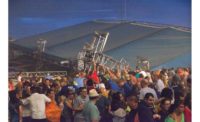Motivated by concern about life safety, inconsistent or nonexistent building code enforcement and a lack of appropriate design guidance, a group of structural engineers has crafted the first-ever environmental hazard load-resistance requirements tailored specifically to public-occupancy temporary structures, such as outdoor stages and tents. The provisions, proposed for the 2024 edition of the model building code, are out for public comment until June 20.
Entertainment-sector special-event interests say the loading requirements, which are stricter than those currently used, would increase the cost of stages and place a serious economic burden on the outdoor-event business.
The need for improved and consistent structural regulation across the U.S. for environmental hazards such as wind, snow, floods and earthquakes became apparent to many building officials in 2011, when there were three temporary-structure failures, including that of a rock concert stage at the Indiana State Fairgrounds. That collapse killed seven people.
No Good Guidance
Groups are building “these temporary structures without good guidance,” says John Hooper, director of earthquake engineering at Magnusson Klemencic Associates and a member of the all-volunteer ad hoc committee of the International Code Council that submitted code-change proposal S116-22 for ICC's 2024 edition of the model International Building Code (IBC).
Donald Scott, a senior principal of PCS Structural Solutions and the leader of the committee, calls S116-22 “very important,” especially for authorities having jurisdiction across the U.S. Building officials “have no uniform or consistent approach to permit temporary structures,” which usually fall under the purview of the fire marshal and the fire code, not the department of buildings, he says.
The proposal would drastically modify IBC chapters 31 and 16. The code currently calls for designing temporary structures to the same standard as permanent structures, which engineers say is overkill. And few if any building officials even enforce the section on public-occupancy temporary structures, according to Ali Fattah, assistant deputy director in the city of San Diego's Development Services Dept., Division of Building Construction and Safety.
The proposal defines public-occupancy temporary structures as new buildings or structures that are used by the general public, or that support public events, where the public expects similar levels of reliability and safety offered by permanent construction. Public-occupancy temporary structures are often assembled with reuseable components that are disassembled and shipped to another event for reassembly. They are designed for a particular purpose and a specific period of time, which the proposal defines as less than one year.
“We are creating a set of provisions that the jurisdiction can use to regulate temporary structures that are accessed by the public,” says Jennifer Goupil, director of codes, standards and technical initiatives at the Structural Engineering Institute of the American Society of Civil Engineers, which develops the bible on design loads, known as ASCE 7.
Lower Design Loads
The goal is to provide lower design loads—compared to permanent structures—for the temporary-structure designers, while maintaining the same level of reliability and risk to the public, adds Goupil, also a member of the ICC ad hoc committee.
“Temporary structures should not pose more risk to occupants than permanent structures, but because the code’s design-level environmental loads are far less likely during a temporary event, this proposal makes adjustments to reduce the requirements for a consistent level of risk,” says the proposal.
Gary Storm, the senior principal with Thornton Tomasetti who investigated the Aug. 13, 2011, fatal collapse of the stage at the Indiana State Fairgrounds, supports the code change proposal. “I think this is a terrific document,” he says.
The components of the stage structure at the fairgrounds were only designed for hanging loads, such as lighting equipment, adds Storm. “This structure had zero capacity for lateral loads,” he says.
Three Failures in 2011
There were three failures of temporary public-occupancy structures in 2011. The circumstances for each event were different but “one common denominator is a lack of [total system] engineering,” Storm adds.
Richard Nix, assistant technical standards manager for the Entertainment Services & Technology Association (ESTA), says the changes would add cost to the stages, thanks to a requirement for a “15.6% increase in design wind speed pressure” over current practice, which is based on the standard for incomplete structures under construction, known as ASCE 37.
“We think it is okay to use ASCE 37 and have been since 2006,” says Nix.
ASCE 37 allows a 60% design load reduction over permanent structure load requirements and S116-22 allows only a 25% reduction, says Fattah, also an S116-22 committee member.
ASCE 37 Not Appropriate
The committee maintains that ASCE 37 is not an appropriate standard to use because construction sites are not occupied by the public. “We oppose the use of ASCE 37” because, unlike the general public, construction workers are trained in safety procedures and understand the implied risk of an incomplete building, says Scott.
“The special event industry was never really entitled” to use ASCE 37 in the first place, for it does not take into account public safety, adds Fattah.
The proposal introduces the concept of controlled occupancy to address cases where an environmental loading hazard cannot be reasonably mitigated and allows for actions based on a pre-approved action plan that the building official may use to allow installations that cannot resist code-prescribed loads.
For example, flood hazard areas and tsunami inundation zones are clearly mapped, and evacuation plans are adopted and include tsunami-alert warning systems. Temporary structures subject to high wind loads may be evacuated and have sections removed to reduce the wind load, says the proposal.
Nix would like to see modifications to the current proposal that would give groups graduated and greater discounts, in terms of load-resistance requirements, based on the life span of the temporary structure and the development of an emergency action plan, such as evacuating the public or taking components down to reduce the hazard.
“We want a higher discount for administrative controls" than is currently proposed, Nix says, adding that he is hopeful a consensus can be reached.
Direct Modification of the Code
It is unusual for structural engineers to propose direct modifications to the IBC, rather than first developing an ASCE standard that is then referenced in the IBC.
“We decided to directly modify the IBC because we could do it faster than waiting for the next edition of ASCE 7,” in 2028, says Hooper. That would be time for inclusion in the 2030 edition of the IBC, he says, adding that the current strategy, if successful, will include provisions in the model code six years sooner.
An ICC public comment hearing, set for Sept. 14-21 in Louisville, Ky., will consider proposed modifications received during the public comment period and provide time for those for and against the code-change proposal to speak out before the vote of eligible members. An on-line governmental consensus vote follows that. The fate of the proposal should be sealed by the end of the year.
The ICC ad hoc committee, which includes members of the main committee of ASCE 7, is gearing up to turn the provisions into ASCE's first-ever consensus standard for public-occupancy temporary structures. “The provisions are 70% to 80% ready for ASCE," says Scott.





Post a comment to this article
Report Abusive Comment